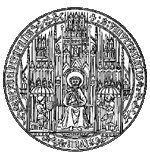
| |
Michael Brunner
Protein Localisation and Circadian Rhythms
Previous and Current research
Almost all organisms generate oscillations with a periodicity of approximately 24 hours. These circadian clocks operate on a cellular level and coordinate a wide variety of physiological processes and behavioral activities. Circadian clocks are self-sustained and persist robustly under constant conditions. Appropriate exogenous stimuli such as light and temperature, so called zeitgebers, entrain circadian clocks to synchronize the endogenous rhythms with the environment. In the past years, substantial progress has been made in the characterization of circadian systems on the molecular level.
A central element of the circadian clock of the filamentous fungi Neurospora crassa is frequency gen, FRQ. Expression of FRQ depends on the transcription factors WC1 and WC2, which form the heterodimeric complex (WCC). frq RNA and FRQ protein levels oscillate under free running conditions (constant darkness) with a period of 22 h. This oscillation is supported by a negative feedback loop. frq mRNA is synthesized in the late subjective night and reaches a maximum in the late morning. Approximately 4 h later, FRQ protein levels reach a maximum. FRQ protein enters the nucleus and, when expressed at sufficiently high levels, represses its own synthesis. In the course of the day, FRQ protein is progressively hyperphosphory-lated and then degraded. When FRQ protein levels fall below a threshold, frq RNA is synthesized again and a new circadian period begins.
Our studies focus on the trafficking of FRQ and the WC proteins between cytosol and nucleus, which regulates the interaction of FRQ with WCC. Furthermore, we analyze the molecular processes which determine the rate of FRQ degradation and thus the length of the circadian day.
Projects for graduate students
Nuclear entry of FRQ and interaction of FRQ with WC2 and WC1 during a circadian day.
Identification of phosphorylation sites in FRQ, which determine its subcellular localization.
Characterization of the casein cinase 1e of Neurospora and hyperphosphorylation of FRQ
Selected publications
Merrow, M., Franchi, L., Dragovic, Z., Görl, M., Johnson, J., Brunner, M., Macino, G. and Roenneberg, T. (2001) Circadian regulation of the light input pathway in Neurospora crassa. EMBO J., in press.
Merrow, M., Brunner, M. and Roenneberg, T. (1999) Novel assignment of circadian function for the Neurospora clock gene frequency. Nature 399, 584-586.
Contact:
Michael Brunner
Biochemie-Zentrum
Universitaet Heidelberg,
Im Neuenheimer Feld 32
D-69120 Heidelberg, Germany